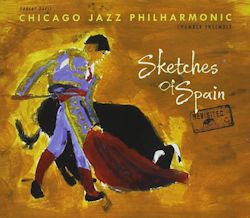Concierto de Aranjuez
Muerte del Matador
El Moreno
El Albaicín
Solea
Orbert Davis’ Chicago Jazz Philharmonic Chamber Ensemble
Recorded Tone Zone Recording, Chicago [44:55]
To rework Sketches of Spain is no mean feat. Wisely, Orbert Davis, invited by Bill Russo to perform the Miles Davis solo part, knew that he had to
do more than play the notes; he had to interpret the original Miles Davis-Gil Evans masterpiece, complete with structural changes and re-instrumentation.
This version, with Russo and the Chicago Jazz Ensemble, was first performed in 1995. Over a decade and a half later Orbert Davis returned to Sketches of Spain with another group from the same city, this time the Chicago Jazz Philharmonic Chamber Ensemble (CJP for short) and more
revisions. There are five movements, as in the original; things start with the finale of Rodrigo’s Concierto de Aranjuez and end with Gil Evans’ Solea but in between the three central movements have been replaced. Instead we hear Muerte del Matador and El Moreno – two new
compositions by Orbert Davis – and El Albaicín, an arrangement by him of Isaac Albéniz’s piano piece. Thus the outer movements, are adaptations
and orchestrations by Orbert Davis of the original pre-existing music, whilst he himself supplies the central music.
The re-conception most manifests itself in terms of different emphases and colours, especially the use of percussion and piano in the Concierto
with Davis catching his namesake’s tonal fragility whilst establishing his own credentials as in individualist by exploring a fuller, richer lower register
and playing muted with considerable sensitivity. The slow evocative Muerte del Matador is braced with gauzy percussion, its funereal cast strongly
but sparely conveyed. El Moreno is full of Moorish saxophone voicings, as well as Flamenco steps, and percussive drama. Here Davis’s tone is
brasher and brassier and there’s a fine tenor sax solo from Steve Eisen. The string quartet of the Ensemble can be best savoured in the opening of El Albaicín. And the closer, Solea, pays homage but not slavish homage to the original.
The virtues of this revistiation of such a classic album lie in the richness of the ensemble work and those creative, often colouristic novelties that
allow it to stand as a musical statement in its own right.
Jonathan Woolf
